Alexithymia manifests in therapy when a patient struggles to identify and describe their emotions, hindering effective emotional processing and communication. Therapists often observe clients providing vague or superficial descriptions of feelings, which complicates the diagnosis of underlying psychological conditions. This emotional bottleneck affects treatment plans, requiring tailored interventions that focus on enhancing emotional awareness and expression. Data from clinical studies indicate that approximately 10% of the general population exhibit alexithymic traits, with higher prevalence rates in individuals with psychosomatic disorders. Therapeutic techniques such as cognitive-behavioral therapy and mindfulness practices have shown efficacy in improving emotional recognition in alexithymic patients. Monitoring patient progress involves assessing improvements in emotional vocabulary and the ability to connect feelings with physical sensations or experiences.
Table of Comparison
| Example of Alexithymia in Therapy | Description | Therapeutic Approach |
|---|---|---|
| Difficulty Identifying Feelings | Client struggles to recognize and label emotional states during sessions. | Use of emotion-focused therapy and guided affect labeling exercises. |
| Limited Emotional Expression | Client exhibits flat affect and minimal verbal emotional disclosure. | Incorporation of creative arts therapy to facilitate non-verbal expression. |
| Concrete Thinking | Client tends to describe physical symptoms rather than emotional experiences. | Cognitive-behavioral techniques aimed at linking bodily sensations to emotions. |
| Difficulty Imagining Others' Feelings | Client shows limited empathy or understanding of others' emotional states. | Use of social skills training and perspective-taking exercises. |
| Confusion Between Emotions and Bodily Sensations | Client misinterprets emotional responses as medical symptoms. | Mindfulness-based interventions to enhance emotional awareness and regulation. |
Understanding Alexithymia: Definition and Key Traits
Alexithymia is characterized by difficulty in identifying and describing emotions, which complicates therapeutic communication and emotional processing. Patients with alexithymia often present with limited emotional awareness, reduced imagination, and a tendency toward externally oriented thinking. Effective therapy requires tailored approaches that enhance emotional recognition and expression to improve mental health outcomes.
Common Signs of Alexithymia in Therapy Sessions
Clients with alexithymia often exhibit difficulty identifying and describing their emotions during therapy sessions, frequently using vague or abstract language to express feelings. They may struggle with recognizing bodily sensations linked to emotions, which hampers emotional awareness and interferes with traditional therapeutic approaches focused on emotional processing. Therapists often observe limited emotional responsiveness and a preference for cognitive rather than affective discussions, highlighting challenges in accessing and articulating inner emotional experiences.
Emotional Expression Challenges in Patients
Patients with alexithymia often struggle to identify and articulate their emotions, presenting significant challenges in therapy sessions. This condition impairs their ability to communicate feelings, leading to difficulties in forming therapeutic alliances and expressing internal experiences effectively. Therapists employ specialized techniques such as emotion-focused interventions and mindfulness to enhance emotional awareness and improve emotional expression in these individuals.
Case Study: Identifying Alexithymia in Practice
A 35-year-old male patient presented with difficulty expressing emotions and describing physical sensations during therapy sessions, indicative of alexithymia. The therapist employed structured emotion identification techniques and body awareness exercises to enhance the patient's emotional recognition and communication. Over several months, notable improvements in emotional articulation and decreased somatic complaints were documented, demonstrating effective identification and intervention strategies for alexithymia in clinical practice.
Therapist Approaches to Assessing Alexithymia
Therapists use structured clinical interviews and self-report questionnaires like the Toronto Alexithymia Scale (TAS-20) to assess alexithymia by evaluating patients' difficulties in identifying and describing emotions. Observational methods during therapy sessions help clinicians detect emotional awareness deficits and impaired affect regulation. Incorporating these assessment tools guides tailored interventions that improve emotional processing and communication skills in individuals with alexithymia.
Communication Barriers: What Therapists Notice
Therapists often observe that clients with alexithymia struggle to articulate emotions, leading to significant communication barriers during sessions. These individuals may describe physical sensations without connecting them to underlying feelings, complicating emotional identification and expression. The lack of emotional vocabulary frequently results in misunderstandings and challenges in building therapeutic rapport.
Therapeutic Techniques for Addressing Alexithymia
Therapeutic techniques for addressing alexithymia include cognitive-behavioral therapy (CBT) to improve emotional recognition and expression, mindfulness-based interventions to enhance emotional awareness, and emotion-focused therapy (EFT) to facilitate deeper emotional processing. Therapists often employ psychoeducation to help clients identify and label their emotions accurately and use skill-building exercises such as journaling and guided imagery. These methods aim to reduce alexithymia symptoms by fostering emotional literacy and improving interpersonal communication.
Building Emotional Awareness: Strategies in Therapy
In therapy, building emotional awareness for individuals with alexithymia often involves guided mindfulness exercises and emotion identification tasks tailored to enhance their ability to recognize and label feelings accurately. Therapists use structured techniques such as emotion wheels and journaling to help patients connect bodily sensations to specific emotions, fostering greater internal awareness. Consistent practice in therapy facilitates improved emotional vocabulary and expression, which are critical for effective interpersonal communication and emotional regulation.
Impact of Alexithymia on Therapeutic Outcomes
Alexithymia, characterized by difficulty in identifying and describing emotions, significantly impacts therapeutic outcomes by hindering emotional processing and expression during sessions. Patients with alexithymia often show reduced engagement and slower progress in cognitive-behavioral therapies due to challenges in recognizing and verbalizing their internal experiences. Addressing alexithymia through tailored interventions, such as emotion-focused therapy, enhances treatment efficacy by improving emotional awareness and facilitating deeper therapeutic rapport.
Supporting Clients with Alexithymia: Best Practices
Supporting clients with alexithymia in therapy requires tailored communication strategies that prioritize emotional identification and expression. Techniques such as using visual aids, guided affect labeling, and mindfulness-based interventions enhance clients' ability to recognize and articulate their feelings. Consistent therapist validation and patience foster a safe therapeutic environment, promoting emotional awareness and engagement.

example of alexithymia in therapy Infographic
 samplerz.com
samplerz.com